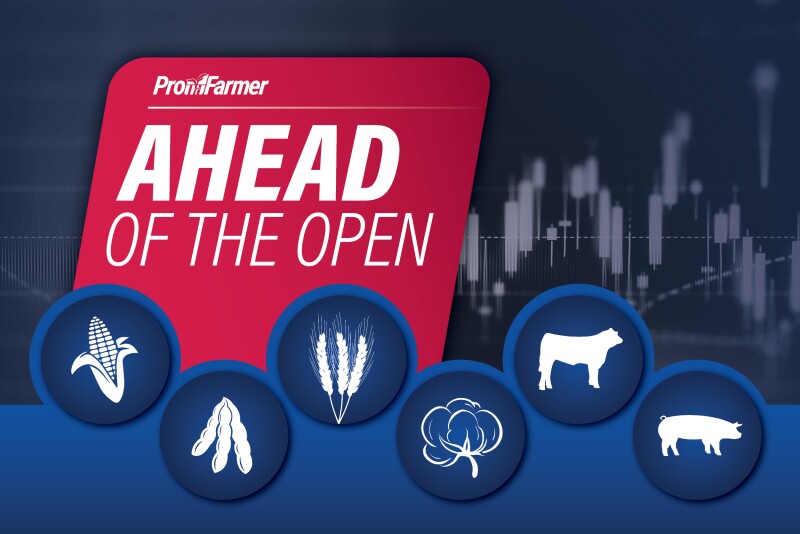GRAIN CALLS
Corn: 1 cent lower to 1 cent higher.
Soybeans: 4 to 6 cents lower.
Wheat: 3 to 5 cents lower.
GENERAL COMMENTS: Wheat saw relative strength overnight, soybeans gave up a portion of recent gains and corn continues to trend sideways. USDA’s Crop Production and WASDE Reports were supposed to come out today but will not. USDA will likely forego the reports completely, punting to November. Outside markets are quiet this morning as both front-month crude oil futures and the U.S. dollar index are modestly higher.
Basis levels for corn and soybeans across the Midwest continue to widen as harvest “is running head on into extraordinarily tight storage capacity,” reports Margy Eckelkamp in a Farm Journal feature story. “Due to the risk of lost export demand, some elevators across the Northern Plains that lack local crush demand may not accept soybeans over fears of not being able to access the export market later,” said Tanner Ehmke, grains and oilseeds economist with CoBank in his latest report. “For elevators reluctant to take delivery and short soybean basis, basis is being set at historically low levels with storage fees set at higher rates.” While domestic soybean crush build out provides a destination — and improved regional basis — for some of the soybeans, it does not offset the big crop and the missing exports to China. Ehmke said with stronger corn demand and it being a bit easier to store in piles or bunkers, elevators will be incentivized toward corn over soybeans. “The challenge for elevators will be prioritizing scarce grain storage,” Ehmke said. “Among the top 12 corn-producing states, the U.S. is facing a 1.4-billion-bushel shortage of upright grain storage this year, with elevators relying more on bunkers and emergency storage like ground piles. This year’s shortage stands in stark contrast to last year when those states had a combined 361 million bushels of excess storage.”
The Wednesday afternoon release of the minutes of the last Federal Reserve Open Market Committee (FOMC) meeting in September showed FOMC members had a willingness to lower interest rates further this year, but many expressed caution due to concerns over inflation. Most members reckoned it likely would be appropriate to ease monetary policy further over the remainder of this year, with new projections showing officials expected two additional quarter-point cuts by year’s end. Participants stressed the importance of taking a balanced approach in promoting the committee’s employment and inflation goals as they considered their next move. Fed officials at that gathering voted 11-1 to lower the Fed funds interest rate range by a quarter percentage point to 4% to 4.25%, the first such cut this year. One official, the newly-sworn-in Stephen Miran, favored a half-point reduction and voted against the decision. The markets showed no significant reactions to the FOMC minutes, as they contained no big surprises.
While there are presently no indications the U.S. government shutdown is close to ending, when it does and backed-up U.S. economic data starts to flow, the marketplace will see increased volatility. That’s what U.S. Treasury traders believe, and bond traders have the reputation of being the smartest guys/gals in the room. The pent-up U.S. data includes reports on employment and inflation. “The delay may complicate the collection of economic figures, making it harder for the Federal Reserve to decide whether to ease again, and options activity shows demand for hedges against a range of Fed scenarios. Traders are preparing for potential turbulence in the $30 trillion U.S. Treasuries market, with options pricing indicating a likelihood of volatility once the data is released, and some expecting jumpy price action if the data is an outlier,” said a Bloomberg report.
CORN: December corn continue to trend sideways. Resistance persists at $4.24 1/2 while bulls are seeking to maintain prices above support ta $4.20 on a push lower.
SOYBEANS: November soybeans saw persistent selling overnight. Bulls are seeking to hold support at $10.22 1/4 on additional selling, while key resistance persists at $10.2, which is reinforced by resistance at yesterday’s high of $10.30.
WHEAT: December SRW wheat posted solid gains overnight. Bulls are seeking a close above 10-day moving average resistance at $5.12 3/4 while support stands at $5.05 on a reversal lower.
LIVESTOCK CALLS
CATTLE: Higher.
HOGS: Choppy/higher.
CATTLE: Cattle futures are expected to open higher in a continuation of recent strength. Feeder cattle rose to record highs on Wednesday as the technical posture has quickly shifted to favor the bulls. Cash cattle trade has had a slow start to the week with just 152 head trading hands at $230.00 through mid-week. Wholesale beef ended Wednesday mixed with choice cutout climbing another 19 cents to $366.16 while select dipped $3.64 to $345.24.
HOGS: Lean hog futures are expected to open with a mostly firmer tone supported by technical buying, but a continuation of recent selling is possible given waning cash fundamentals. The CME lean hog index is down another 72 cents to $100.70 as of Oct. 7, extending the seasonal slide. Pork cutout sunk $2.21 Wednesday to $103.82 as all cuts posted losses on the day, though movement surged to 405.2 loads, indicating higher demand at lower prices.

